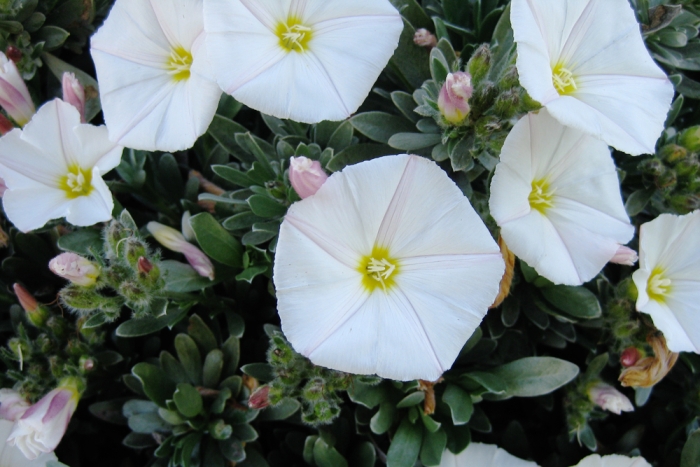Silverbush
(Convolvulus cneorum)
Silverbush (Convolvulus cneorum)
/
/

Jessie Hirsch
CC BY 2.0
Image By:
Jessie Hirsch
Recorded By:
Copyright:
CC BY 2.0
Copyright Notice:
Photo by: Jessie Hirsch | License Type: CC BY 2.0 | License URL: https://creativecommons.org/licenses/by/2.0 | Uploader: Flickr upload bot | Publisher: Wikimedia Commons | Title: Silverbush_(Convolvulus_cneorum).jpg | Notes: Transferred from Flickr via #flickr2commons |






















































Estimated Native Range
Summary
Convolvulus cneorum, commonly known as Silverbush, is an evergreen subshrub native to the central Mediterranean region. It is adapted to dry, rocky soils and thrives in full sun, reflecting its origin from open, sunny habitats such as coastal scrub and rocky hillsides. This plant typically forms a low, dense mound ranging from 0.6 to 1.2 meters in height and width, with a silvery appearance due to its grey-green leaves covered in fine hairs.
Silverbush is celebrated for its long flowering season, from spring to summer, with pink buds that open to reveal white flowers, each about 2.5 to 4 cm in diameter, with a yellow throat. These blossoms are borne in loose panicles at the end of stems and can almost completely cover the plant, creating a striking display. It is a favored choice for rock gardens, Mediterranean-themed landscapes, and as a container plant due to its compact form and drought tolerance. Silverbush requires alkaline soil, full sun, and good drainage to flourish. It is cold hardy to -9°C and can withstand short periods of near-drought conditions. The Royal Horticultural Society has recognized it with the Award of Garden Merit for its ornamental value and ease of maintenance. However, it can be susceptible to root rot in poorly drained soils and may suffer from frost damage in colder climates.CC BY-SA 4.0
Silverbush is celebrated for its long flowering season, from spring to summer, with pink buds that open to reveal white flowers, each about 2.5 to 4 cm in diameter, with a yellow throat. These blossoms are borne in loose panicles at the end of stems and can almost completely cover the plant, creating a striking display. It is a favored choice for rock gardens, Mediterranean-themed landscapes, and as a container plant due to its compact form and drought tolerance. Silverbush requires alkaline soil, full sun, and good drainage to flourish. It is cold hardy to -9°C and can withstand short periods of near-drought conditions. The Royal Horticultural Society has recognized it with the Award of Garden Merit for its ornamental value and ease of maintenance. However, it can be susceptible to root rot in poorly drained soils and may suffer from frost damage in colder climates.CC BY-SA 4.0
Plant Description
- Plant Type:
- Height: 1-2 feet
- Width: 2-3 feet
- Growth Rate: Moderate
- Flower Color: White
- Flowering Season: Summer
- Leaf Retention: Evergreen
Growth Requirements
- Sun: Full Sun
- Water: Low, Medium
- Drainage: Fast
Common Uses
Bee Garden, Bird Garden, Border Plant, Butterfly Garden, Deer Resistant, Drought Tolerant, Groundcover, Hummingbird Garden, Low Maintenance, Potted Plant, Rock Garden, Salt Tolerant, Showy Flowers
Natural Habitat
sunny habitats such as coastal scrub and rocky hillsides
Other Names
Common Names: Shrubby Bindweed
Scientific Names: , Convolvulus cneorum, Convolvulus argenteus, Sciadiara cneorum,
GBIF Accepted Name: Convolvulus cneorum L.